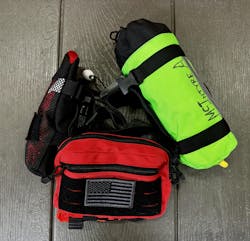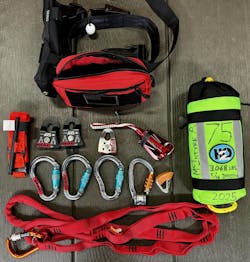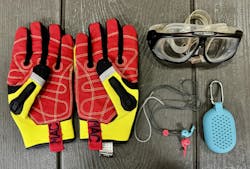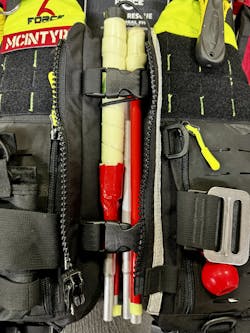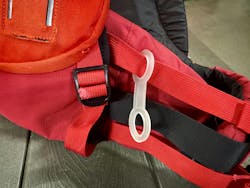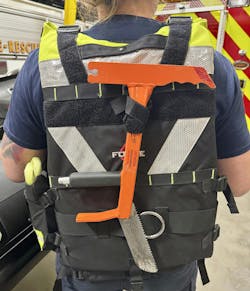Swiftwater environments are dynamic situations. As a whitewater river guide, the only tools that I have available to me are what are on my person or in my boat. However, every rescuer must have the proper equipment to handle operational tasks.
First responders are accustomed to showing up with a big toolbox that’s at their disposal. That said, although members might arrive at a water-rescue incident on the apparatus, operations could take them too far to return to the vehicle for gear, and it could take too long for another member to bring the rescuers additional equipment. Being self-sufficient is advantageous in the world of water rescue.
There’s considerable crossover between my experience as a whitewater river guide and responding to a swiftwater-rescue emergency with the fire department or urban search and rescue team. In “The Clean Principle for Swiftwater Rescue”, I wrote about personal flotation devices (PFDs), other swiftwater-rescue equipment and the necessity to ensure that the risk of entanglement is minimized. Below, I expand on the Clean Principle, the tools that water-rescue technicians might carry and how to carry them (i.e., your kit) during a rescue.
4-3-2-1
As a river guide, a “4-3-2-1” is the basic on-the-water rescue kit: four carabiners, three pulleys, two prusiks and one 20-foot roll of webbing. Along with the throw bag, the 4-3-2-1 provides the necessary hardware to create basic mechanical advantage systems—the philosophy being, “I have my kit, you have your kit, and together we can handle most rescues.”
Carrying the big rigging bag off of the rescue truck and into the water isn’t practical. Carrying the 4-3-2-1 in a small, waist-mounted pouch or in the pockets of a PFD provides the needed gear at all times.
NFPA G-rated steel carabiners can be quite large and heavy. In a water environment, it’s important for rescuers to consider what forces are being applied to their gear and what safety factor is necessary for the given tasks. A 15:1 safety factor is a standard that’s set by manufacturers, but it doesn’t apply with certainty to what rescuers do in the real world.
In a high-angle environment, rescuers typically operate at about a 7:1 safety factor with NFPA G-rated equipment. To compare other disciplines, rock climbers typically operate with a 5:1 safety factor or less, and fire service aerial ladders are rated at a 2:1 safety factor.
What is the acceptable safety factor for swiftwater gear? In my opinion, 5:1 is more than sufficient. Horizontal rope systems place less force on equipment than a vertical system does. Backyard testing during a horizontal movable control point evolution (a high line that was operated horizontally with an inflatable boat as the load) showed the average load to be about 400 pound-force (lbf) on the anchor, maxing out at 900 lbf when the tracking line was detensioned. These nonscientific numbers show that forces that are exerted on the equipment are low enough to use NFPA T-rated or non-NFPA-rated equipment if the department allows. Using lighter equipment means that the rescuer isn’t overburdened with gear.
Pulley/rope compatibility
Rope that’s 11 mm is making great headway into the fire service. This opens up the option for smaller and lighter equipment.
Throw bag rope typically is 11 mm and smaller. Micropulleys are an excellent option for these smaller ropes.
Pulleys that have a diameter of about 1 inch are lightweight and small and easily fit into a pouch or pocket. Some efficiency is sacrificed with a smaller pulley, but the gains outweigh the loss.
Magnapulleys from Anderson Rescue Solutions (ARS) are an innovative way to have a double pulley or two single pulleys in one package. They provide the benefit of a double pulley, when most manufacturers advise not to pair single pulleys next to each other to craft a double. In the urban environment, there usually is something metal readily available to stick the
Magnapulley on while you rig gear, preventing it from dropping into the water or getting lost.
Rope grabs
Rope grab devices have evolved greatly. Traditional rope grabs have been prusiks; however, not all prusiks are created equal. Hollow-block prusiks are advantageous in water rescue,; they grab on a wider range of rope diameters than traditional prusiks.
Doubling up on prusiks might be necessary to prevent the slippage that occurs once the rope is wet.
Toothed rope grabs have their place, but there’s some debate on the safety of these devices with wet rope under tension. I have used toothed rope grabs and continue to carry them in my kit, but this is an individual decision for each rescuer.
Webbing
Webbing also has evolved. The ARS Strap is a multiloop webbing strap that has a wide range of applications.
ARS offers a carry bag that’s designed particularly for the water environment, which makes it convenient to both drain water and to attach to a PFD for rapid deployment. Traditional webbing continues to prove useful, because it’s compact and can be rolled up tightly.
Both ARS Straps and webbing can be used for anchor points, Swiss seat harnesses, rope tethers for a horizontal rope system, boat anchor points, boat flip lines, casualty extrication and animal leashes.
Vehicle-in-water operations
Automobiles that were driven into flood waters typically are the most frequent responses for urban swiftwater-rescue teams. Keeping up to date with automobile technology helps rescuers to defeat the systems that are designed to keep people inside of an automobile.
Tempered glass can be defeated easily. ResQme tools have a spring-loaded center punch and seatbelt cutter. Glass breakers that require the user to pull back the spring might not be effective when the window is submerged.
Laminated, or safety, glass is used in more side windows. Defeating laminated glass requires some type of cutter. Glas-Master saws have been standard in the vehicle rescue world since I was a junior firefighter, and one rescuer usually is designated to carry this tool during a vehicle-in-water response. Drill-operated cutters are a bit bulkier, heavier and expensive and aren’t waterproof.
Once an automobile is cleared of occupants, it’s helpful to mark the vehicle to prevent multiple responses to it. Caution tape usually is carried on every apparatus. Create a smaller roll that can fit inside of a pocket. Surveyor tape is another good option. It’s small, so it can fit inside of a pocket, and its fluorescent colors can be seen easily. Paint isn’t a great option because of the wet surfaces and the bulky nature of spray paint cans.
Mark the highest point on the vehicle (roof rack or antenna), so it can be seen if the water continues to rise.
Medical
In the movie “Lone Survivor,” Marcus Luttrell, who is played by Mark Wahlberg, states, “There is no medicine in a gunfight.” In other words, take care of the emergency first, then treat wounds.
Members who serve on swiftwater-resuce teams can apply the basis of that thinking: Get the victim out of harm’s way first, then treat the individual’s wounds.
Drowning and near-drowning victims are unique, because their heart could be beating although they aren’t breathing. In these cases of respiratory arrest, rescue breathing becomes paramount over chest compressions. Purging the carbon dioxide buildup in the victim’s system might be enough to return spontaneous breathing. Rescue technicians should be ready for water to come back up the airway from the lungs.
Barrier devices are standard. Small keychain barriers can be vacuum-sealed for protection and kept inside of a PFD pocket.
Treating traumatic injuries in a water environment can be difficult, because the water might wash away interventions. Massive hemorrhaging must be controlled, and a tourniquet is perfect for this application. Combat Application Tourniquets (CATs) can be carried inside of a pouch that’s on a belt, on a PFD or inside of a pocket.
Gauze and other tools for treating wounds might become saturated, which would render them ineffective at stopping the bleed. If packing a wound and a pressure dressing are required, try to keep the area dry by sealing it from the elements. Chest seals, plastic taped down or duct tape might work. In most cases, rescuers will transfer the victim to the care of medics more quickly than the rescuers can pack wounds.
Miscellaneous gear
Mike Mathers of Mathers Rescue demonstrated at the Oklahoma Swiftwater Conference how he carries and uses a collapsible blind walking cane. These canes are lightweight, have a small profile and are carried behind the zipper for a front-opening PFD. The canes are brightly colored for visibility and are reflective. Although these might not be strong enough to provide support for a wading rescue, they can be used for an individual to stand at a specific spot, check a floor in a flooded building, check the depth for boat motors and as a reaching device, a glass-breaker and a signaling device. Applying glow tape to canes increases their usefulness at night.
Gloves are important protection: If rescuers injure their hands, they’re out of the fight. Cut and abrasion resistance with a good grip on wet rope is ideal. Because neoprene material works great to retain water, one must keep in mind that contamination held next to the skin must be avoided. Neoprene also is cut easily, so it provides little protection to the user. Breaching glass in automobiles and buildings requires the use of more cut-resistant gloves.
Scuba diving octopus (octo) holders are pieces of rubber that are used to hold a secondary regulator on scuba gear. Rescuers can use octo holders in swiftwater by attaching one end to the blowout strap and leaving the other end free for carabiners. Most Type-V PFDs that are designed for fire department use don’t have a breakaway spot for the tethers that rescuers might carry, which creates an entrapment hazard. Clipping the tether to the octo holder creates a weak link to break in case the tether becomes entangled. Using the octo holder to temporarily clip carabiners to while rigging systems is another use.
Clean Principle
Examine your gear to look for ways that you could become trapped by your equipment, then try to find a better way to carry it.
Belts are a great option; they can be released with the squeeze of two fingers in the event that they become a hazard. Furthermore, they fit under the PFD, which creates a more streamlined profile than attaching pouches to the PFD itself.
Equipment carried by swiftwater rescuers must reflect the operating environment. That said, equipment only gets rescuers so far. Competence and training is just as crucial. Training is continual, particularly in regard to perishable skills, such as water and rope rescue. Having the right training, the right equipment, at the right time, will make you successful.
About the Author
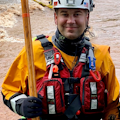
Andrew McIntyre
Andrew McIntyre has been in the fire service since 2003, serving in both career and volunteer departments, on urban search and rescue teams, and as an instructor. Further work as a whitewater river guide, ski patroller, scuba divemaster and mountaineer brings a wide range of knowledge and experience. McIntyre is a U.S. Marine Corps. infantry veteran.
